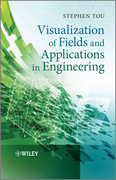
INDICE: Preface Chapter 1 Introduction 1.1 A general view 1.2 Historical development and progress in visual science 1.3 Scientific visualization philosophy, techniques and challenges Chapter 2 Field descriptions and kinematics 2.1 Lagrangian/Eulerian description and transformation 2.2 Curvilinear coordinatesPolar coordinate Streamline (Flux line) coordinate Potential-stream function coordinate 2.3 Field kinematics and visual attributes Chapter 3 Field model, representation and visualization 3.1 Field models and concepts 3.2 Scalar fields and representation 3.3 Vector fields and representation 3.4 Vector icons andclassifications 3.5 Scalar potential 3.6 Vector potential 3.7 Vector field specification and contraction Helmholtz's theorem 3.8 Tensor contraction and transport process visualization Mechanical energy function and heatfunction Strain energy trajectory and strain function 3.9 Multiple fields and interactions Chapter 4 Complex analysis and complex potentials 4.1 Complex variables/functions and applications 4.2 Complex analysis and Cauchy-Riemann equation 4.3 Differentiation of complex function 4.4 Integration of complex function 4.5 Visualization of complex potentials Trajectory method Curvilinear squares theory and field map construction Transfer characteristics and field property evaluation Example 4.1.a Visualization of heat and fluid transport in a corner Chapter 5 Field mapping and applications 5.1 Introduction 5.2 Mapping of Euclidian geometry 5.3 Inversion mapping 5.4 Mapping with complex functions 5.5 Conformal mapping and applications 5.6 Hodograph method and mapping 5.7 Hodograph representations and applications Straight boundaries Free surfaces Special field patterns Projectile trajectory in constant force fields Motion trajectory in centralforce fields Trajectory of charged particles in uniform magnetic fields Example 4.1.b (continue) Mapping of field patterns and image warping Chapter 6 Tensor representation, contraction and visualization 6.1 Introduction 6.2 Development of tensor visualization techniques 6.3 Tensor description and representation Tensor icons and classification 6.4 Tensor decomposition and tensor rank reduction 6.5 Visualization of symmetric tensors Tensor invariants Tensor transformations Principal states and Eigenanalysis Hybrid method of tensor visualization 6.6 Visualization of antisymmetric tensors Vorticity concepts and dynamics Forced vortex Free vortex Vorticity transport and vorticity function Example4.1.c (continue) Convective momentum flux tensor visualization Chapter 7 Critical point topology, classification and visualization 7.1 Introduction 7.2 Complex analysis of critical point 7.3 Critical point theory and classification Symmetric tensors Antisymmetric tensors Asymmetric tensors Example 4.1.d (contin
- ISBN: 978-0-470-97397-4
- Editorial: John Wiley & Sons
- Encuadernacion: Cartoné
- Páginas: 344
- Fecha Publicación: 14/01/2011
- Nº Volúmenes: 1
- Idioma: Inglés
